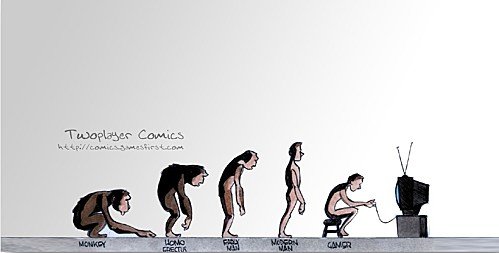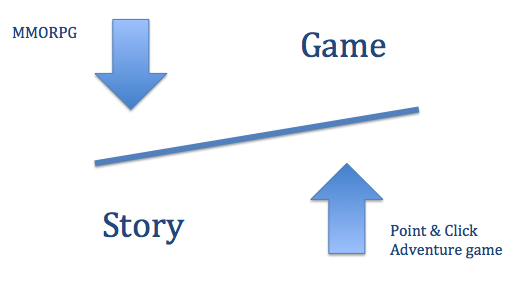Original post: http://www.electro-gn.com/304-jeuetnarration-premierepartie
Translation: Vincent Choupaut
—
This article is stemming from a lecture given at the “GNiales” in 2009. The first part, “Game and Narration”, will try to establish the links between games and stories, and the consequences for larp. A second article, “Tree larp”, will suggest a model to create better stories in larps.
Let me explain: Everything which follows is born after a commonplace conversation around a beer, or two, or… a lot. Thanks to the power of yeasts, I felt there was something to dig. The alcohol effect passed away, the impression remained. Let see what stands out.
I have a problem. I like beautiful stories and I like games. But what is good for a game is not necessarily good for a story, and vice versa.
Video game: Locomotive of thoughts on games
My approach is mostly fed with my interest in video games. You might think that these loans are strange, or even inappropriate, to talk about larps. So I want to convince you that this approach is legitimate.
If we take “Game” in the broad sense, that is grouping all the spheres of activity which concern games, the field of video games is probably the place where thoughts are the most broad and stimulating. Thoughts that show themselves through hundreds of forum pages and specialized blogs, hundreds of studies and books.
The tabletop role-playing games have their own studies and books, certainly, but most of them are concentrated on the general public, and their interest is limited for a diligent larper. Another part of literature is more a defence of role-playing games, and only a few works remain to enlighten us deeply on the practice of the activity. Thoughts on larps are still embryonic… even if things are changing. We have to go where things are happening.
In the world of video games, many authors gained experience in the fields of board games of role-playing games. So we can’t suspect them to have a limited view. Some of them (my favorite ones) know larp, because they studied or practiced it.
We would be wrong to think that problems in video games are just a matter of source code, graphic engine and level design. If some of the problems of the game designers are of course linked to the medium, other ones are the same that in other areas of play. Video game is now a mature leisure, diversified, and which became a true locomotive for thoughts on games.
That’s the case for the problem I want to tackle with you: the conflict between “ludologists” and “narratologists” is previous to the development of video games, but it grew and became more complex since they appeared. This conflict puts categories which allow us to question larp, and why not, design new experiences of games.
Video Game: game OR narrative medium
On my left hand, the ludologists, who consider games as formal systems. They are interested in gameplay and mechanics, independently of the content of the game. The elements of the story are secondary incidents. On my right hand, the narratologists, who view games as media telling stories, and whose main reference is the narrative theory.
For the ludologists, every game is not telling a story. They are above all technical devices. To understand them, we don’t have to use the tools of dramatic analysis…
For the narratologists, games are media which allow living narrative experiences. Before moving forward, we can examine a definition of narration, by J. Hillis Miller, in Critical Terms for Literary Study:
– A narration has an initial state, a change of this state, and a view of the outcome. We can call this process: The events of the narration.
– A narration is not simply a series of events, but the expression of these events through a medium like the language. This part of the definition refers to the representation side of the narration.
– This representation is composed of modeling and repetition. It is true for every level of a narration, whether it is the material form of narration itself or its abstract theme.
On this basis, Eric Zimmerman noticed that a novel or a “Choose your own adventure book” matches with the definition, but that is also the case for chess: It has an initial state, a change of this state and an end / it is a representation (a stylized representation of war) / it is organized around a structured plan of time (the different turns) and space (the chessboard). It works also for a wedding ceremony, etc.
We may admit with narratologists that games have a more or less strong link with narration. However, the ludologists blame the narratologists for having a too much wide conception of what is a story:
Outside academic theory people are usually excellent at making distinctions between narrative, drama and games. If I throw a ball at you I don’t expect you to drop it and wait until it starts telling stories.
(Eskelinen, 2001: http://www.gamestudies.org/0101/eskelinen/ )
Besides, admitting that we could plan a story on every game, every game has not for GOAL to tell a story.
Not all games tell stories. Many of my own favorite games – Tetris, Blix, etc. – are simple graphic games that do not lend themselves very well to narrative exposition. To understand such games, we need other terms and concepts beyond narrative, including interface design and expressive movement for starters.
(Henry Jenkins, 1999)
Video Game: game AND narrative medium
Do not think that this debate is a fierce battle. Actually, it is largely artificial. The ludologists, as the narratologists, ask us simply to study and design games, favoring gameplay for the first ones, and story for the others.
Actually, Tetris is behind us for ages. More and more video games integrate, at various degrees, narrative elements. There are very different kinds of games, and according to the genre and the game, we can see complex hybridizations between narration and gameplay.
Ex.: Starcraft. As a real-time strategy game, it has a gaming dominant. When the game starts, the player has a precise mission objective, and juggle from a control to another to elaborate a victorious strategy. So there is a gaming dominant.
However, Starcraft integrates strong narrative elements. The different missions center around a story whose strength and quality were saluted by players and critics. Before each mission, the course of war is staged with rich briefing scenes. After each mission, the player can watch the consequences of his victories through cutscenes. Every battle sequence is a step towards the next dramatic plot of the story. Every battle integrates likewise elements of scriptwriting (for example, the surprised arrival of an allied battleship will overthrow the course of battle).
It is the same thing for other kinds of games: In history of shooting game, we came from Duck Hunt to Crisis, in which a scenario, with which the player can interact, justifies the fact that you are shooting people.
The headache of stories to be played
Within the development studios, game designers are facing concrete problems. The tension between game elements and narrative elements arises at every step of game design, from the first idea to the interface realization…
We have to notice with Greg Costikyan, that game and story make the sparks fly:
In other words, there’s a direct, immediate conflict between the demands of story and the demands of a game. Divergence from a story’s path is likely to make for a less satisfying story; restricting a player’s freedom of action is likely to make for a less satisfying game. To the degree that you make a game more like a story – a controlled, predetermined experience with events occurring as the author wishes – you make it a less effective game. To the degree that you make a story more like a game – with alternative paths and outcomes – you make it a less effective story. It’s not merely that games aren’t stories, and vice versa; rather they are, in a sense, opposites.
Greg Costikyan (http://www.electronicbookreview.com/thread/firstperson/storyish)
Interactivity is almost the opposite of narrative; narrative flows under the direction of the author, while interactivity depends on the player for motive power
Ernest Adams, “Three Problems For Interactive Storytellers,” Gamasutra
Computer games are not narratives….Rather the narrative tends to be isolated from or even work against the computer-game-ness of the game.
Jesper Juul, “A Clash Between Games and Narrative” (1998)
Every author agrees on one point: good stories don’t make good games, and vice versa. I didn’t really speak about larp yet, but it was necessary to present first what was said on this topic and is not new in the world of video games. In the second part of this article, we’ll see how we can apply these thoughts to larp, and which questions could emerge.






